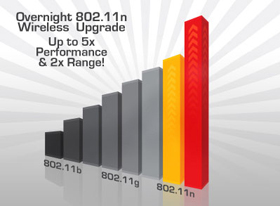Plan to upgrade 802.11n LAN wireless
 Network administration - The deployment of 802.11n access points (APs) is an important step, but it is only a part of enterprise network upgrades. From speed and capacity to support real-time applications and corporate network access with important tasks, 802.11n has many advantages but it also has its own difficulties for LANs. wireless (WLAN). To take advantage of 802.11n, businesses must plan not only for AP hardware but also for new client devices, network infrastructure development, management tools upgrades and human resource training.
Network administration - The deployment of 802.11n access points (APs) is an important step, but it is only a part of enterprise network upgrades. From speed and capacity to support real-time applications and corporate network access with important tasks, 802.11n has many advantages but it also has its own difficulties for LANs. wireless (WLAN). To take advantage of 802.11n, businesses must plan not only for AP hardware but also for new client devices, network infrastructure development, management tools upgrades and human resource training.
Upgrade WLAN to increase workload
Upgrading an existing WLAN to get 802.11n APs will consume a portion of the wireless controller's capacity and network bandwidth. In addition, many businesses will use 802.11n to expand wireless services to support more users, new applications and wider coverage. To avoid unexpected surprises, businesses must predict the amount of traffic the wireless system will provide and how to develop this wireless network over time.
A typical 802.11a / b / g AP operates at a data rate of up to 54 Mbps, but only half of the actual data is transmitted in that total throughput because it contains the overhead in each packet. data. Depending on the product and configuration, 802.11n APs can increase the maximum data rate to 300 Mbps, then replacing an old AP with a new 802.11n AP will increase the maximum load from 54 Mbps. up to 300 Mbps.
However, there are very few WLANs that will immediately transition to new clients and applications to fully utilize the available wireless capacity. In a short term, a practical calculation is to use a transceiver to support 802.11g clients and other transceivers that support 802.11n clients, at which time the combined throughput is not too over 204 Mbps.
In this way you should plan for network upgrades to achieve a four-time workload on WLAN controllers, links used to provide traffic to the distribution network of you, as well as the distribution layer switch. This growth will appear gradually as client devices are upgraded to 11n, so study the cycle of refreshing handhelds and notebooks to anticipate the difference over time for Your workforce.
Fix the bottleneck in WLAN upgrades
When planning to upgrade the network, one important thing you need to do is consider where to place the new 802.11n AP and where it connects to the corporate network.
Some new APs can support cable connectivity to existing WLAN controllers and have storage capacity, but others need to upgrade their WLAN controllers - especially when using 802.11n. to expand coverage. In specific locations (ie branch offices or small offices), you should install autonomous 802.11n APs so that they do not include traffic through an internal controller. In these cases, find and eliminate bottlenecks through WLAN design and configuration. For example, route the actual internal WLAN traffic from the AP to the AP to reduce the delay and workload of the controller.
Next, consider the links and connect WLAN controllers (autonomous APs) to your wired distribution network. Some 10 / 100Mbps Ethernet links need to be upgraded to Gigabit Ethernet - if not between the controller and switch, it is possible between switches. Another way is to use 802.11n to execute 5 GHz wireless simultaneously - especially in difficult wiring situations. With higher capacity and faster data rates, 802.11n is able to handle the high demand for simultaneous traffic. But besides, do not forget the AP reserves to ensure availability.
Plan for the supply demand of 802.11n
When used at maximum capacity, 802.11n APs often consume more resources to control a series of multiple-input multiple-output (MIMO) transceivers and complex CPUs. Businesses that still have legacy APs using the 802.3af Power over Ethernet (PoE) standard may find that the new 3 x 3 MIMO 802.11n AP uses up to 12.95 W more per port.
 Despite the stability of today's APs on the 802.11n standard, most of this is just the new generation of enterprise WLAN products. Next year's APs will probably integrate better with chipsets and there will be other ways to optimize power consumption. Therefore, PoE may or may not be an issue in your 802.11n deployment, which is entirely dependent on the products you choose, the switches with PoE features that you use and how you configure them. How is your WLAN image?
Despite the stability of today's APs on the 802.11n standard, most of this is just the new generation of enterprise WLAN products. Next year's APs will probably integrate better with chipsets and there will be other ways to optimize power consumption. Therefore, PoE may or may not be an issue in your 802.11n deployment, which is entirely dependent on the products you choose, the switches with PoE features that you use and how you configure them. How is your WLAN image?
Ask your WLAN vendors to estimate PoE consumption for each AP, in the specific configurations you plan to deploy. For example, if an AP has two transceivers and both sets in 3 x 3 MIMO mode to load, then you should temporarily consider using one of the transceivers in mode 2. x 2. No need to use all the features in the new 802.11n APs immediately but instead, plan to deploy additional PoE ports such as upgraded distribution switches, that is, inserting power supplies in really necessary places.
Expand the 802.11n management tool
Because 802.11n APs will basically communicate in a new way, they require planning for an upgrade network, in addition to troubleshooting and testing tools. Existing WLAN tools can be used for some 802.11n APs - for example, WLAN analyzers and WIPS wireless intrusion systems will detect the presence of 802.11n APs. active in blending and inheriting modes. However, the legacy 802.11a / b / g transceivers used by such systems cannot receive or decode all of the data broadcast with 802.11n improvements such as tape channels. 40 MHz width or frame grouping method. To do their job well, these tools must be updated to meet the requirements of 802.11n.
A note in the implementation of 802.11n APs, optimal performance and investment responsiveness can be obtained by planning WLAN upgrades with a predictive modeling tool. Invest in modern RF planning tools to understand the features of the 802.11n protocol and the spread of MIMO signals, which can encourage configurations that optimize placement and options. Especially when switching from a data WLAN to a mixed WLAN, use planning tools to map devices and users within the coverage of the application, accepting a quality of service. somehow.
During WLAN deployment, handheld tools are needed to support location statistics and connectivity debugging. These tools are not only equipped with new 802.11n adapters, they also have to understand the results of changes in 802.11n. For example, using location statistics tools will allow you to measure not only signal strength but also application throughput - not just in one direction but in both directions. Using diagnostic tools can correctly identify 802.11n type errors instead of comparing PDU fields and bit maps. Enhance the testing features provided by 802.11n APs - they have a view in the RF environment and can record useful observations at the time a transient issue occurs.
Improved WLAN testing process 802.11n
After deployment, it is necessary to use centralized security and performance testing systems to monitor 802.11n networks. 802.11n WLANs are more dynamic and will use techniques like spatial distribution and dynamic frequency selection to cover some of their own problems. However, when these problems appear, they will happen at a higher speed and affect more users and many applications. The only effective way to solve these challenges is to monitor your entire WLAN 24/7 in a way that can analyze and deliver the fastest action.
For example, because 802.11n will expand the range of WLANs, unconfirmed connections or accidental connections may invade your network more. Upgrade WIPS detectors (APs can be configured to act as detectors) for 802.11n traffic parsing and covering all affected areas. Configure automatic response policies to block unauthorized intrusion (including Greenfield AP 802.11n). Use positioning techniques to understand multi-path mechanisms to quickly assess the impact of unauthorized intrusion and search and remove them.
Most companies will experience immediate increase in throughput and coverage when deploying 802.11n. However, 802.11n protocols and its options are so complex that WLANs are almost impossible to operate at the highest performance without additional investments in training and support tools. Upgrade RF performance testing tools for analyzing and evaluating 802.11n options - not just in general but requiring an understanding of specific APs and clients used within your WLAN . Finding tools that not only optimize performance but also help administrators visualize the impact of possible changes - and then enforce them by defining and pushing configuration updates in automatic form.
While these management and network infrastructure upgrades are not entirely mandatory when moving to 802.11n, they are necessary investments. Upgrading to 802.11n without network capacity, no control will be like controlling a high-performance race car on a narrow road with a hazy viewfinder and no brake pedals. Planning a WLAN with the right tools you can avoid unnecessary problems and be successful at the highest probability.
 10 free and useful network tools
10 free and useful network tools Turn an old computer into an access point
Turn an old computer into an access point Tips for setting up and configuring a Hotspot
Tips for setting up and configuring a Hotspot TMG 2010 ISP Redundancy Feature (Part 1)
TMG 2010 ISP Redundancy Feature (Part 1) Creating SSL Server 2008 Server with ISA 2006 Firewalls (Part 1)
Creating SSL Server 2008 Server with ISA 2006 Firewalls (Part 1) Creating SSL Server 2008 Server with ISA 2006 Firewalls (Part 2)
Creating SSL Server 2008 Server with ISA 2006 Firewalls (Part 2)